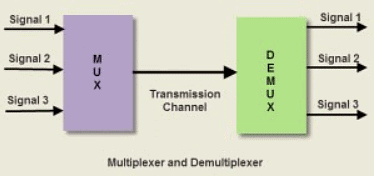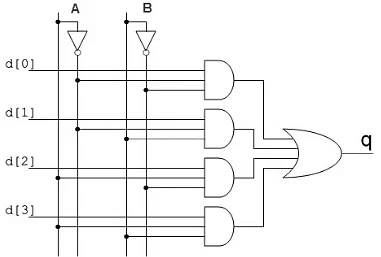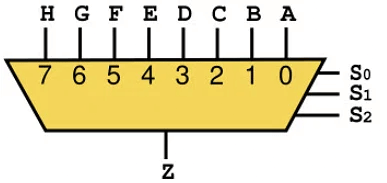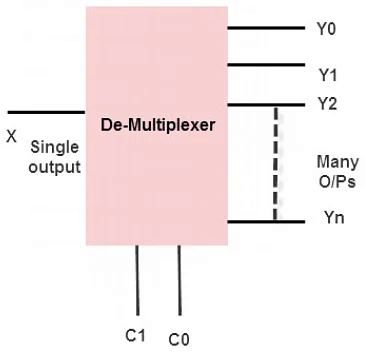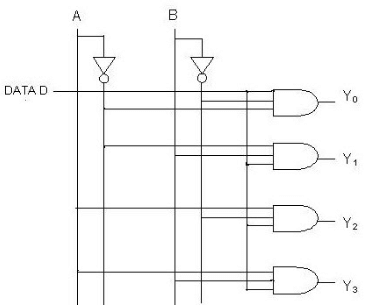Multiplexer & Demultiplexer | Digital Logic - Computer Science Engineering (CSE) PDF Download
What are Multiplexer and Demultiplexer?
- In-network transmission, both the multiplexer and demultiplexer are combinational circuits. A multiplexer selects an input from several inputs then it is transmitted in the form of a single line. An alternative name of the multiplexer is MUX or data selector. A demultiplexer uses one input signal and generates many. So it is known as Demux or data distributor.

What is a Multiplexer?
- The multiplexer is a device that has multiple inputs and single line output. The select lines determine which input is connected to the output, and also increase the amount of data that can be sent over a network within a certain time. It is also called a data selector.
- The single-pole multi-position switch is a simple example of a non-electronic circuit of the multiplexer, and it is widely used in many electronic circuits. The multiplexer is used to perform high-speed switching and is constructed by electronic components.

- Multiplexers are capable of handling both analog and digital applications. In analog applications, multiplexers are made up of relays and transistor switches, whereas in digital applications, the multiplexers are built from standard logic gates. When the multiplexer is used for digital applications, it is called a digital multiplexer.
Multiplexer Types
Multiplexers are classified into four types:
- 2-1 multiplexer ( 1select line)
- 4-1 multiplexer (2 select lines)
- 8-1 multiplexer(3 select lines)
- 16-1 multiplexer (4 select lines)
4-to-1 Multiplexer
- The 4X1 multiplexer comprises 4-input bits, 1- output bit, and 2- control bits. The four input bits are namely 0, D1, D2, and D3, respectively; only one of the input bits is transmitted to the output. The o/p ‘q’ depends on the value of control input AB. The control bit AB decides which of the i/p data bit should transmit the output. The following figure shows the 4X1 multiplexer circuit diagram using AND gates. For example, when the control bits AB =00, then the higher AND gates are allowed while remaining AND gates are restricted. Thus, data input D0 is transmitted to the output ‘q”

- If the control input is changed to 11, then all gates are restricted except the bottom AND gate. In this case, D3 is transmitted to the output, and q=D0. If the control input is changed to AB =11, all gates are disabled except the bottom AND gate. In this case, D3 is transmitted to the output, and q = D3. The best example of a 4X1 multiplexer is IC 74153. In this IC, the o/p is the same as the i/p. Another example of a 4X1 multiplexer is IC 45352. In this IC, the o/p is the compliment of the i/p
8-to-1 Multiplexer
- The 8-to-1 multiplexer consists of 8 input lines, one output line, and 3 selection lines.

8-1 Multiplexer Circuit
- For the combination of a selection input, the data line is connected to the output line. The circuit shown below is an 8*1 multiplexer. The 8-to-1 multiplexer requires 8 AND gates, one OR gate, and 3 selection lines. As an input, the combination of selection inputs is giving to the AND gate with the corresponding input data lines.
- In a similar fashion, all the AND gates are given connection. In this 8*1 multiplexer, for any selection line input, one AND gate gives a value of 1 and the remaining all AND gates give 0. And, finally, by using OR gates, all the AND gates are added; and, this will be equal to the selected value.

Advantages and Disadvantages of Multiplexer
The advantages of multiplexer include the following.
- In multiplexer, the usage of a number of wires can be decreased
- It reduces the cost as well as the complexity of the circuit
- The implementation of a number of combination circuits can be possible by using a multiplexer
- Mux doesn’t require K-maps & simplification
- The multiplexer can make the transmission circuit less complex & economical
- The dissipation of heat is less because of the analog switching current which ranges from 10mA to 20mA.
- The multiplexer ability can be extended to switch audio signals, video signals, etc.
- The digital system reliability can be improved using a MUX as it decreases the number of exterior wired connections.
- MUX is used to implement several combinational circuits
- The logic design can be simplified through MUX
The disadvantages of multiplexer include the following.
- Additional delays required within switching ports & I/O signals which propagate throughout the multiplexer.
- The ports which can be utilized at the same time have limitations
- Switching ports can be handled by adding the complexity of firmware
- The controlling of multiplexer can be done by using additional I/O ports.
Applications of Multiplexers
Multiplexers are used in various applications wherein multiple-data need to be transmitted by using a single line.
Communication System
- A communication system has both a communication network and a transmission system. By using a multiplexer, the efficiency of the communication system can be increased by allowing the transmission of data, such as audio and video data from different channels through single lines or cables.
Computer Memory
- Multiplexers are used in computer memory to maintain a huge amount of memory in the computers, and also to reduce the number of copper lines required to connect the memory to other parts of the computer.
Telephone Network
- In telephone networks, multiple audio signals are integrated on a single line of transmission with the help of a multiplexer.
Transmission from the Computer System of a Satellite
- The multiplexer is used to transmit the data signals from the computer system of a spacecraft or a satellite to the ground system by using a GSM satellite.
What is Demultiplexer?
- De-multiplexer is also a device with one input and multiple output lines. It is used to send a signal to one of the many devices. The main difference between a multiplexer and a de-multiplexer is that a multiplexer takes two or more signals and encodes them on a wire, whereas a de-multiplexer does reverse to what the multiplexer does.

Types of Demultiplexer
Demultiplexers are classified into four types
- 1-2 demultiplexer (1 select line)
- 1-4 demultiplexer (2 select lines)
- 1-8 demultiplexer (3 select lines)
- 1-16 demultiplexer (4 select lines)
1-4 Demultiplexer
- The 1-to-4 demultiplexer comprises 1- input bit, 4-output bits, and control bits. The 1X4 demultiplexer circuit diagram is shown below.

- The i/p bit is considered as Data D. This data bit is transmitted to the data bit of the o/p lines, which depends on the AB value and the control i/p.
- When the control i/p AB = 01, the upper second AND gate is permitted while the remaining AND gates are restricted. Thus, only data bit D is transmitted to the output, and Y1 = Data.
- If the data bit D is low, the output Y1 is low. IF data bit D is high, the output Y1 is high. The value of the output Y1 depends upon the value of data bit D, the remaining outputs are in a low state.
- If the control input changes to AB = 10, then all the gates are restricted except the third AND gate from the top. Then, data bit D is transmitted only to the output Y2; and, Y2 = Data. . The best example of 1X4 demultiplexer is IC 74155.
1-8 Demultiplexer
- The demultiplexer is also called a data distributor as it requires one input, 3 selected lines, and 8 outputs. De-multiplexer takes one single input data line and then switches it to any one of the output lines. The 1-to-8 demultiplexer circuit diagram is shown below; it uses 8 AND gates for achieving the operation.

- The input bit is considered as data D and it is transmitted to the output lines. This depends on the control input value of the AB. When AB = 01, the upper second gate F1 is enabled, while the remaining AND gates are disabled, and the data bit is transmitted to the output giving F1= data. If D is low, the F1 is low, and if D is high, the F1 is high. So the value of the F1 depends on the value of D, and the remaining outputs are in the low state.
Advantages and Disadvantages of Demultiplexer
The advantages of demultiplexer include the following.
- A demultiplexer or Demux is used to divide the mutual signals back into separate streams.
- The function of Demux is quite opposite to MUX.
- The Audio or Video signals transmission needs a combination of Mux and Demux.
- Demux is used as a decoder within the security systems of banking sectors.
- The communication system efficiency can be enhanced through the combination of Mux & Demux.
The disadvantages of demultiplexer include the following.
- Bandwidth wastage might happen
- Because of the synchronization of the signals, delays might take place
Applications of Demultiplexer
- Demultiplexers are used to connect a single source to multiple destinations. These applications include the following:
Communication System
- Mux and demux both are used in communication systems to carry out the process of data transmission. A De-multiplexer receives the output signals from the multiplexer and at the receiver end, it converts them back to the original form.
Arithmetic Logic Unit
- The output of the ALU is fed as an input to the De-multiplexer, and the output of the demultiplexer is connected to multiple registers. The output of the ALU can be stored in multiple registers.
Serial to Parallel Converter
- This converter is used to reconstruct parallel data. In this technique, serial data is given as an input to the De-multiplexer at a regular interval, and a counter is attached to the demultiplexer at the control input to detect the data signal at the output of the demultiplexer. When all data signals are stored, the output of the demux can be read out in parallel.
Difference between Multiplexer and Demultiplexer
The main difference between multiplexer and demultiplexer is discussed below.

Key Difference between Multiplexer and Demultiplexer
The key differences between multiplexer and demultiplexer are discussed below.
- The combinational logic circuits like multiplexer and demultiplexer are used within communication systems however their function is accurately opposite to each other because one works on multiple inputs whereas the other works on only input.
- Multiplexer or Mux is an N-to-1 device whereas demultiplexer is a 1-to-N device.
- A multiplexer is used to convert several analog or digital signals into a single o/p signal through different control lines. These control lines can be determined by using this formula like 2n=r where ‘r’ is the no of i/p signals & ‘n’ is the no of required control lines.
- The data conversion method used in MUX is parallel to serial and it is not difficult to understand because it uses different inputs. However, DEMUX works quite reverse to MUX like a serial to parallel conversion. So, the number of outputs can be achieved in this case.
- A demultiplexer is used to convert one i/p signal to several. The number of control signals can be determined by using the same formula of MUX.
- Both the Mux and Demux are used to transmit the data over a network in less bandwidth. But multiplexer is used at the transmitter end whereas the Demux is used at the receiver end.
|
32 docs|15 tests
|

|
Explore Courses for Computer Science Engineering (CSE) exam
|

|
